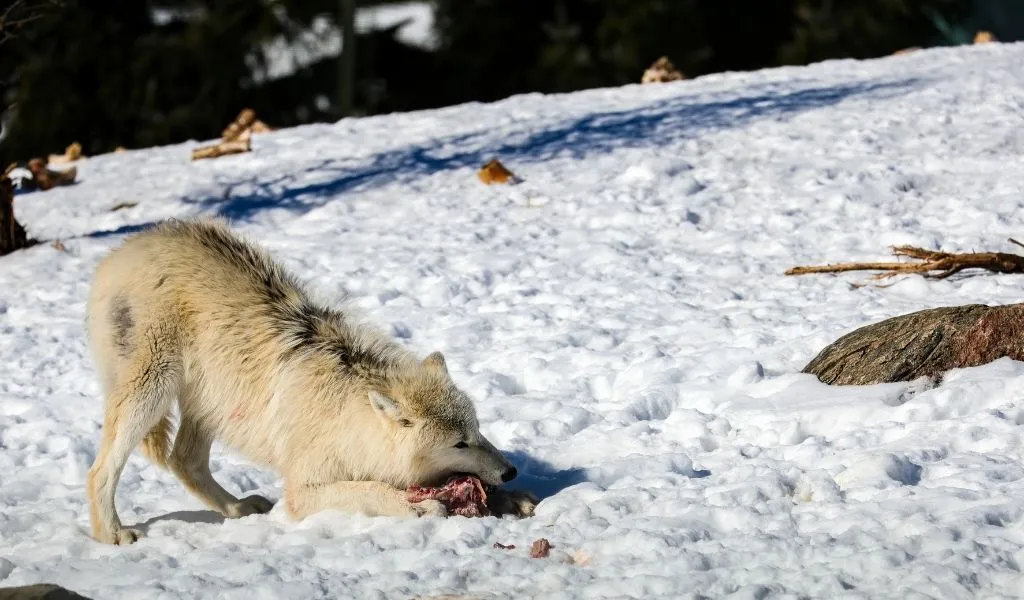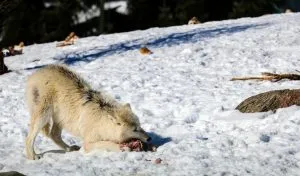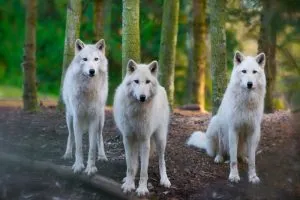The arctic wolf is a remarkably resilient animal that takes up residence in some of the most isolated and precarious habitats in the world. They live in regions where few other flora and fauna dare try to survive. So, where exactly do arctic wolves live?
Arctic wolves live in the high Arctic regions of Canada and Greenland. Their habitat is a vast arctic tundra that supports very little wildlife. To survive in such a terrain, this hardy wolf has developed specific behaviors and morphologies suited to a life of harsh winters, scarce resources, and fierce territorial battles.
Read on to learn about the recent genetic research debating arctic wolf classifications, novel adaptations the wolves use to survive sub-zero climates, and discover how long the wolves on Ellesmere Island have been using the same den!
Where Do Arctic Wolves Live?
Arctic wolves live in the high Arctic regions of Canada and Greenland.
They can be found specifically in the Canadian Arctic Archipelago on Victoria Island, Banks Island, Baffin Island, and Ellesmere Island. Arctic wolves found in Victoria and Banks Island are called ‘west arctic wolves’ whilst those found on Baffin Island are named ‘east arctic wolves. Lastly, wolves found on Ellesmere Island are named ‘polar wolves’.
Additionally, a distinct population can be found along the northern and eastern shores of Greenland. These populations are also named the ‘polar wolves’.
The islands and regions aforementioned have very few human inhabitants. This allows arctic wolves to thrive as the apex predator in vast landscapes left relatively untouched by human interference1 (source: Population genomics of grey wolves and wolf-like canids in North America | PLOS Genetics).

What Are Arctic Wolves Habitats?
Arctic wolves live, mate and hunt within the arctic tundra. This is a vast treeless landscape consisting of mostly permafrost and snow. This area receives ~10 inches of rainfall each year making it a desert2 (source: Tundra Biome | National Geographic Society).
For a measly 6-10 weeks in summer, a thin layer of soil thaws enough for plants. The only plants able to survive in the harsh landscape tend to be very low-to-ground; small shrubs, grasses, mosses, and lichens 3(source: Tundra Biome | National Geographic Society).
Year in and year out the arctic wolf survives and endures harsh, relentlessly cold, and windy conditions. And for 5 months out of the year, this resilient wolf lives in complete and utter darkness.
Arctic wolf adaptations
In order to survive in such extreme conditions, the arctic wolf has had to develop certain novel adaptations such as…
- Two layers of fur: The arctic wolf has an undercoat that keeps warm air close to its body and a long-haired outer coat that is used as protection from rain and snow.
- White coloration: They are the only sub-species of wolves to have white coloration. Their white fur allows them to camouflage into their snowy habitat thus masking them from prey. This allows a higher chance of success when hunting. However, black arctic wolves have been reported! Researchers believe this is likely due to a genetic mutation that produces melanin and thus black fur.
- Shorter extremities: The arctic wolf has shorter muzzles, legs, and ears than other species of wolves. This results in their extremities being kept closer to their warm chest and stomach4 (source: Arctic Wolf: The High Arctic – Laura DeLallo – Google Books).
- Furry paws: Arctic wolves have fur between the pads of their large paws. This keeps their paws warm on the icy terrain and prevents cold injury5 (source: Arctic Wolf: The High Arctic – Laura DeLallo – Google Books).
- Increased blood flow to their paws: When walking on cold terrain, the wolves are able to increase blood flow to their paws (vasodilation). This allows the tissues in their feet to stay above freezing level. This differs from the mechanism in humans. When humans enter a cold environment vasoconstriction occurs whereby blood flow to fingers and toes is restricted to conserve body heat. Mankind would not fare as well as the arctic wolf in sub-zero conditions!6 (source: Arctic wolves have unique adaptation to protect their paws (wolf.org)
- Increased territory size: Arctic wolf territories are often much larger than grey wolf territories. This is due to the vast lengths of the arctic tundra that is void of many food resources. Therefore, wolf packs claim larger territories that have a sufficient amount of food for survival. These territories can surpass 1,000 km2. 7(source: How do wolves choose the size of their territory? (wolf.org)
Where Do Arctic Wolves Make Their Dens?
Arctic wolves dig their dens into the snow and use permanent natural structures such as boulders or rock caves to stabilize their dens and withstand extreme weather conditions. Often, they do this near bodies of water, however, this can be difficult to do in frozen conditions.8 (source:145possibleuseofwolfden.pdf)
The digging of new dens year in and year out would use up a lot of the wolves’ vital energy needed to survive in the harsh climate. Therefore, arctic wolves will frequently reuse old dens dug by previous wolves.9 (source: Wolves thrive in some of the harshest places on Earth | Nature of Things (cbc.ca)
Amazingly, there is one den found on Ellesmere Island that arctic wolves have been using for the past 783 years! Scientists were able to approximate how long the den has been in use by radiocarbon dating bones found around the den.10 (source: Wolves thrive in some of the harshest places on Earth | Nature of Things (cbc.ca)
The dens themselves are characterized by several entrances leading to an enlarged chamber where the pups and mother are kept. When the pups grow and mature they leave the den and will travel with the pack.11 source: A Ten Year History of the Demography and Productivity of an Arctic Wolf Pack | International Wolf Center
Arctic wolf dens are usually elevated for the detection of potential rival packs and raiders. Curiously, whilst the north American grey wolf is inclined to change dens throughout the year to avoid predation, the same cannot be said for the arctic subspecies. Moving dens would put young pups at risk of cold injury if forced to travel across many square kilometers to a new den. As a result, the arctic wolf will frequently choose to stand their ground rather than desert.
How Many Arctic Wolves Are There in the World?
Arctic wolf sightings are rare and often an inaccurate representation of pack size due to pups remaining hidden in wolf dens. Due to this, it is very difficult for researchers to reach a conclusion on just how many arctic wolves are in the wild.
Researchers have noted 303 arctic wolf sightings in Greenland between 1978-1998.12 source: Insular and disjunct distribution of the Arctic wolf in Greenland, 1978–1998 | SpringerLink (gla.ac.uk) Another study sighted ~950 individuals over 12 years in Northwestern Canada13 source: Wolf–Caribou Dynamics Within the Central Canadian Arctic (gla.ac.uk).
Via accumulation of population surveys and research, a suggestion of 2000 arctic wolves in the wild has been made.
Importantly, the IUCN Red List classifies the species as ‘ Least Concern’ (LC).
However, over the past few years, the arctic wolf is becoming increasingly threatened by processes such as industrial development and climate change. These infringe on the arctic wolves’ territories and can disrupt their food supply14 (source: Arctic Wolf | Species | WWF (worldwildlife.org).
For more information, read our article: How Many Arctic Wolves Are Left? Are They Endangered? [2023]

Where Do Arctic Wolves Come From?
The arctic wolf originated from the North American grey wolf. Its taxonomic name is Canis lupus arctos. (Canis lupus coming from the grey wolf and arctos meaning arctic). 15(source: Arctic Wolf | Species | WWF (worldwildlife.org)
It has been proposed that, relatively recently, the North American grey wolf migrated north and colonized regions of the arctic tundra. Over time, they developed adaptations to the cold climate and became the distinct populations of the arctic wolves we see today.
Recent genetic research looking at the genetic diversity between different subspecies of grey wolves has made some interesting findings; Three distinct populations of high arctic wolves have been classified; ‘west arctic’, ‘east arctic’, and ‘polar’. The polar wolves found in Ellesmere and Greenland have been found to be the most genetically distinct population from the grey wolf and the west and east arctic wolves. This is due to their increased period of reproductive isolation from the grey wolf and high amounts of inbreeding.16 Population genomics of grey wolves and wolf-like canids in North America | PLOS Genetics
Related Questions
Do Arctic Wolves Live in Europe?
Yes. Greenland, despite being geographically in the range of the North American continent, is named part of Europe. Arctic wolves live on the northern and eastern coasts of Greenland.17 Population genomics of grey wolves and wolf-like canids in North America | PLOS Genetics
Where Do Arctic Wolves Live in North America?
Arctic wolves live in the Canadian Arctic Archipelago in North America.18 Population genomics of grey wolves and wolf-like canids in North America | PLOS Genetics
Where Do Arctic Wolves Live in Canada?
Arctic wolves live in the Victoria, Banks, Ellesmere, and Baffin islands of the Canadian Arctic Archipelago.19 Population genomics of grey wolves and wolf-like canids in North America | PLOS Genetics




![Read more about the article How Many Arctic Wolves Are Left? Are They Endangered? [2023]](https://polarguidebook.com/wp-content/uploads/2023/06/Untitled-design-9-300x200.png)
